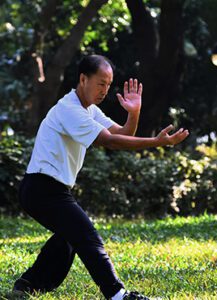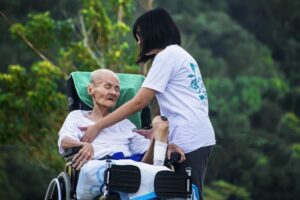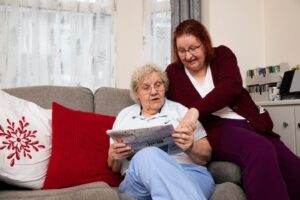Page Contents
In many nursing homes, elderly residents often lead sedentary lifestyles, contributing to a lack of energy and a decline in overall well-being. This inactivity can be particularly detrimental to their physical and mental health. The reasons for this inactivity vary—some residents may be frail, others might have cognitive impairments such as dementia, and some may be bed-bound due to various health conditions. Nursing home operators have the responsibility to create an environment that encourages and facilitates activity, tailored to the diverse needs of the residents. By doing so, we can significantly enhance their quality of life and possibly, extend their healthy life span.
Activities for the frail elderly
For frail residents, activities must be gentle yet engaging. Here are a few suggestions:
1. Seated exercises
Simple chair-based exercises can improve circulation and maintain muscle mass and strength without putting too much strain on the body. These can include leg lifts, arm circles, and gentle stretches.
2. Tai Chi and Yoga
Tai Chi and Yoga are low-impact activities that can help improve balance, flexibility, and mental well-being. Modified versions of these practices can be performed seated or standing with support.
3. Walking clubs
Short, supervised walks around the facility or in a garden area can provide physical exercise and a change of scenery, boosting both physical and mental health.
4. Interactive games
Games like balloon volleyball or light-weight bowling can be fun and promote movement without being too strenuous.

Activities for residents with dementia
Residents with dementia benefit from activities that stimulate their minds and provide sensory engagement:
1. Music therapy
Playing familiar songs can evoke memories and emotions, promoting cognitive engagement and emotional well-being. Group singing sessions can also be beneficial.
2. Art therapy
Drawing, painting, and crafting can provide a creative outlet and improve hand-eye coordination. These activities can be tailored to individual abilities.
3. Memory boxes
Creating boxes with objects that are familiar to the residents can help evoke memories and stimulate conversation. These can be themed around different periods of their lives or interests.
4. Simple puzzles and games
Puzzles, matching games, and other cognitive activities can help keep the mind active and engaged.

Activities for bed-bound residents
For bed-bound residents, activities should focus on maintaining engagement and preventing isolation:
Bed exercises
Gentle bed exercises, such as leg lifts, arm movements, and hand squeezes, can help maintain muscle tone and circulation.Sensory stimulation
Items like textured fabrics, scented oils, and soft music can provide sensory engagement and comfort.Reading and storytelling
Reading aloud to residents or listening to audiobooks can be stimulating and enjoyable. Personal stories and reminiscence therapy can also be highly beneficial.Technology
Tablets and other devices can be used for video calls with family, virtual tours, and interactive games that residents can enjoy from their beds.
Creating a cozy and conducive living environment
It is crucial to ensure that the living environment is not only safe but also comfortable and stimulating. Here are some strategies to create a conducive living environment:
1. Personalised spaces
Allow residents to personalise their living spaces with photos, favorite items, and decorations to create a homely and familiar atmosphere.
2. Common areas
Design common areas that are inviting and encourage social interaction. Comfortable seating, good lighting, and pleasant decor can make these spaces more appealing.
3. Outdoor access
Ensure residents have access to outdoor spaces, such as gardens or patios, where they can enjoy fresh air and nature. These areas should be safe and easily accessible.
4. Engaging staff
Train staff to interact positively and encouragingly with residents. Staff should be proactive in engaging residents in activities and creating a lively, supportive environment.

5. Routine and variety
Establish a daily routine that includes a mix of activities to provide structure and predictability, while also introducing variety to keep things interesting and stimulating.
Involving family members
Family members play a critical role in enhancing the quality of life for elderly residents. Here are some ways to involve them:
1. Regular visits
Encourage family members to visit frequently. Regular interactions with loved ones can provide emotional support and reduce feelings of loneliness.
2. Family participation in activities
Invite family members to join in on activities and events. This can include attending exercise classes, participating in art therapy sessions, or joining in on game nights.
3. Special events and celebrations
Organise special events, such as holiday celebrations, birthdays, and family days, where family members are encouraged to participate and celebrate with residents.
4. Communication and updates
Keep family members informed about the well-being and progress of their loved ones. Regular updates through newsletters, emails, or meetings can help them stay connected and involved.
5. Volunteer opportunities
Create opportunities for family members to volunteer at the nursing home. They can help with activities, provide companionship (befriending), or assist with outings.

Conclusion
Ensuring that elderly residents in nursing homes remain active and engaged is a critical aspect of their overall wellness and well-being. This task requires the dedication and extra effort of caregivers, who play a vital role in the daily lives of residents. By providing a variety of tailored activities and creating a cozy, supportive environment, we can foster a sense of vitality and improve the quality of life for our residents.
Involving family members in this process adds an invaluable layer of emotional support and connection. It is essential for caregivers to be attentive, compassionate, and proactive in their approach, continually seeking ways to enhance the physical, mental, and emotional health of those in their care. Through collective effort and attention to detail, we can make a profound difference in the lives of our elderly residents, ensuring they feel valued, engaged, and well-cared for in their golden years.
